Trier
![]()
This article is about the city of Trier. For other meanings of Trier, see Trier (disambiguation).
· 
Constantine the Great, Roman Emperor, also resided in Trier
· 
Balduin of Luxembourg, one of the most important electors of Trier; depiction on the Balduin fountain
· 
Karl Marx statue on Simeonstiftplatz square
Trier (French Trèves, Luxembourgish Tréier) (Latin Augusta Treverorum) is an independent city in the west of the state of Rhineland-Palatinate. With about 110,000 inhabitants, it is its fourth largest city after Mainz, Ludwigshafen am Rhein and Koblenz.
The city was founded more than 2000 years ago under the name Augusta Treverorum (from the second half of the 3rd century Treveris) and claims the title of the oldest city in Germany. Here, Trier invokes the longest history as a city already recognized by the Romans, as opposed to a settlement or army camp.
The Roman monuments in Trier have been UNESCO World Heritage Sites since 1986. These include the amphitheater, the Baths of St. Barbara, the Imperial Baths, the Constantine Basilica, the Porta Nigra, the Roman Bridge and the Igel Column in Igel. Trier's World Heritage Site also includes the Romanesque cathedral and the early Gothic Church of Our Lady. In addition, there are cultural monuments in Trier from almost all eras from early history to the 21st century.
Trier is the seat of the University of Trier and Trier University of Applied Sciences, the administration of the Trier-Saarburg district, the administration of the Trier-Land association municipality, the Supervisory and Service Directorate (ADD, until 1999 the Trier district government), several offices of the State Investigation Office (LUA), an office of the Rhineland-Palatinate State Office for Social Affairs, Youth and Supply, a Roman Catholic diocese (Trier diocese, the oldest north of the Alps) and the Protestant church district of Trier.
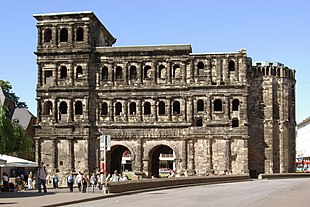
The inner city side of the Porta Nigra. The photo below was taken from the center of the upper floor.
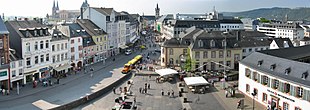
View from the Porta Nigra into the Simeonstraße .
Geography
Trier lies in the middle of a valley widening of the middle Moselle valley with the main part on the right bank of the river. Forested slopes, some of which are covered with vineyards, rise to the plateaus of the Hunsrück in the southeast and the Eifel in the northwest. The border with the Grand Duchy of Luxembourg (Wasserbillig) is about 15 km from the city center. The nearest larger cities are Saarbrücken, about 80 kilometers southeast, Koblenz, about 100 kilometers northeast, and Luxembourg City, about 50 kilometers west of Trier.
Trier Switzerland is an older name for the local recreation and excursion area of the city of Trier on the left bank of the Moselle. Around 1905, Trier Switzerland had a capacity of about 1800 guests, who could have been catered for simultaneously in nine inns in this area.
Due to the predominantly rural surrounding area, Trier has a relatively large catchment area - for its size - consisting of large parts of the Moselle valley, lower Saar valley, Eifel and Hunsrück; see also: Trier region.
The altitude of Trier ranges from 124 m above sea level on the Moselle just before Schweich to 427 m above sea level on the Kuppensteiner Wild near Trier-Irsch. The altitude of the city center, measured at the main market square, is 137 m above sea level.
On the right side of the Moselle is the Petrisberg, on the left side of the Moselle is the Pulsberg/Markusberg with the Mariensäule and the Kockelsberg. Tributaries of the Moselle are from the right Kobenbach, Aulbach, Olewiger Bach, Aveler Bach, Gruberbach, Meierbach and Ruwer and from the left Zewenerbach, Eurenerbach, Sirzenicher Bach with Gillenbach, Biewerbach, Kyll and Quintbach.
·
Moselle in Trier
· 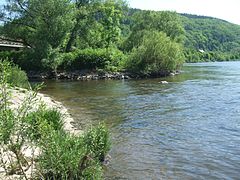
Ruwermündung
· 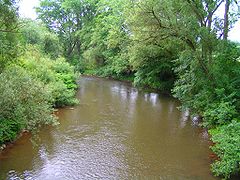
Kyll
· 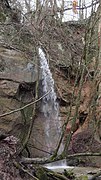
Gillenbach
·
Sirzenicher brook
Trier is the name of the Ordnance Survey map sheet No. 6205 of the topographic map at the scale of 1:25,000.
Neighboring communities
The independent city of Trier is completely surrounded by the district of Trier-Saarburg. In the immediate vicinity, just a few kilometers away, are also the Eifelkreis Bitburg-Prüm and the district of Bernkastel-Wittlich.
Neighboring communities are clockwise (starting in the north):
- Schweich, Longuich, Kenn and again Longuich in the area of the Verbandsgemeinde Schweich on the Roman Wine Route
- Mertesdorf, Kasel, Waldrach, Morscheid, Korlingen and Gusterath in the area of the Ruwer association municipality
- Hockweiler and Franzenheim in the area of the municipality of Trier-Land
- Konz and Wasserliesch in the area of the municipality of Konz
- Igel, Trierweiler, Aach, Newel, Kordel and Zemmer in the area of the Trier-Land association municipality
City breakdown
The city of Trier is divided into 19 districts. In each local district there is a local advisory council consisting of 9 to 15 members and a local chairman. The local councils must be consulted on important matters affecting the local district. The final decision on a measure is the responsibility of the City Council. The local advisory councils can also decide independently on smaller measures in the local district within the framework of a budget allocated to them.
The local districts include a total of 28 urban districts, 10 of which are identical in their characteristics to the local district.
Local districts with area and number of inhabitants (primary and secondary residence)
| No. | Local district | Area | Inhabitants | Inhabitants | Residents |
| 11 | Center/Gardenfeld (Old Town, Garden Field) | 294,7 | 12.648 | 12.256 | 12.784 |
| 12 | North (Nells Ländchen, Maximin) | 375,6 | 14.256 | 13.628 | 14.231 |
| 13 | South (Barbara, Matthias) | 164,8 | 9.409 | 9.386 | 9.428 |
| 21 | Ehrang/Quint (Ehrang, Quint) | 2.522,9 | 9.397 | 9.133 | 9.130 |
| 22 | Pfalzel | 238,5 | 3.558 | 3.543 | 3.517 |
| 23 | Biewer | 515,6 | 1.985 | 1.860 | 1.934 |
| 24 | Ruwer/Eitelsbach (Ruwer, Eitelsbach) | 910,3 | 3.142 | 3.020 | 3.039 |
| 31 | West/Pallien (Pallien, Trier-West) | 841,2 | 7.117 | 7.053 | 7.406 |
| 32 | Yours | 1.271,5 | 4.116 | 4.271 | 4.280 |
| 33 | Zewen | 783,6 | 3.695 | 3.564 | 3.621 |
| 41 | Olewig | 305,4 | 3.312 | 3.076 | 3.271 |
| 42 | Kürenz (Old Kürenz, New Kürenz) | 584,6 | 8.578 | 9.567 | 10.280 |
| 43 | Tarforst | 550,2 | 6.827 | 6.688 | 6.692 |
| 44 | Filsch | 149,6 | 830 | 836 | 1.514 |
| 45 | Irsch | 395,0 | 2.410 | 2.290 | 2.211 |
| 46 | Kernscheid | 381,6 | 999 | 936 | 900 |
| 51 | Feyen/Weismark (Feyen, Weismark) | 538,3 | 5.845 | 5.866 | 7.081 |
| 52 | Heiligkreuz (Old Heiligkreuz, New Heiligkreuz) | 203,2 | 6.766 | 6.676 | 6.840 |
| 53 | Mariahof | 678,5 | 3.212 | 3.031 | 2.979 |
| City of Trier | 11.705,1 | 108.102 | 106.680 | 111.138 |
See also: List of places in the independent city of Trier
Climate
The city is located in the temperate climate zone. The average annual temperature is 9.3 °C and the average annual precipitation is 774 millimeters. In the measurement period between 1993 and 2013, the average annual temperature was 10.09 °C. The average annual precipitation in the same period was 765.9 mm, so it has not changed noticeably. The warmest months are June to August with an average of 16.1 to 17.8 °C and the coldest are December to February with an average of 0.6 to 1.6 °C. The most precipitation falls from October to December with an average of 70 to 80 millimeters, and the least in February and April with an average of 52 millimeters. Precipitation is in the middle third of the values recorded in Germany. Lower values are recorded at 52% of the measuring stations of the German Weather Service. In December, 1.5 times more precipitation falls than in April. Precipitation varies only minimally and is distributed extremely evenly throughout the year. Only 1 % of the measuring stations register lower seasonal variations than in Trier.
| Trier | ||||||||||||||||||||||||||||||||||||||||||||||||
| Climate diagram | ||||||||||||||||||||||||||||||||||||||||||||||||
| ||||||||||||||||||||||||||||||||||||||||||||||||
| Monthly average temperatures and precipitation for Trier
Source: DWD (Memento from April 10, 2014 in the Internet Archive); wetterkontor.de | ||||||||||||||||||||||||||||||||||||||||||||||||||||||||||||||||||||||||||||||||||||||||||||||||||||||||||||||||||||||||||||||||||||||||||||||||||||||||||||||||||||||||||||||||||||||||||||||||||||||||||||||||||||||||||||||||||||||||||||||||||||||||||||
On August 8, 2003, during the 2003 European heat wave, a heat record of 39 °C was measured in Trier.
Spatial planning
In Rhineland-Palatinate, Trier forms one of the five major centers, for the medium-sized centers Bernkastel-Kues, Bitburg, Daun, Gerolstein, Hermeskeil, Konz, Neuerburg, Prüm, Saarburg, Traben-Trarbach and Wittlich.
Trier is a co-founder of the "German Regiopolis Network" established in Rostock in March 2016.
There is strong excess demand for rental and owner-occupied apartments in the city of Trier: According to a survey by the Federal Institute for Research on Building, Urban Affairs and Spatial Development (BBSR), Trier had the highest rent increase in Germany between 2005 and 2010. The Trier-Saarburg district ranks third in the nationwide ranking with a 13.4 percent increase in rents. The reason for this development is Trier's geographical proximity to Luxembourg.
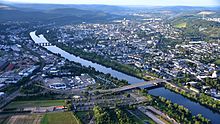
Trier, aerial view (2016)

Marian column on the Pulsberg/Markusberg
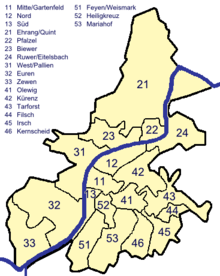
Local Districts
Politics
At the head of the city of Trier since 1302 stood the Schöffenmeister, occasionally also called mayor. The Schultheiss was the representative of the archbishop's sovereign rights over the city. In the 15th century there were two mayors at the top. There was always a dispute with the archbishop about the status of the town. In 1795, the French occupation introduced the collegiate municipality constitution. In 1798 the mairie constitution was introduced and some suburbs were incorporated. In 1801 a new municipal constitution followed, which was essentially retained until 1845, with the mayor using the title Oberbürgermeister from 1818 (Trier had become a city district in the meantime). The lord mayor was also the district administrator of the Trier district (until 1851). In 1856 the city received the "Rheinische Städteordnung". The municipal council decided in favor of the mayor's constitution (as opposed to the magistrate's constitution). With the Prussian Municipal Constitution Act of 1933 and the German Municipal Code of 1935, the Führer principle was enforced at the municipal level. After World War II, a mayor was initially appointed, elected by the city councillors in 1946. He was initially honorary, since 1949 again full-time.
Trier is part of the Trier federal constituency and the Trier and Trier/Schweich state constituencies.
City leaders
The city leaders since the 18th century:
- until 1794: Ludwig Karl Gottbill, Mayor of Trier, in the Electorate of Trier
- 1794-1796: Ludwig Karl Gottbill, first mayor of Trier, during the French period
- 1796-1797: Matthias Gedeon Dupre, Maire
- 1797-1800: Franz Heddesdorf, president of the municipal administration
- 1800-1810: Anton Joseph Recking, Maire
- from 1810: Heinrich Leistenschneider, Maire
- 1815-1817: Anton Joseph Recking, first Lord Mayor of Trier, under Prussian administration
- 1818-1840: Wilhelm von Haw
- 1840-0000: F. A. Kayser (acting)
- 1841-1848: Franz Damian Görtz
- 1849–1862: Franz Xaver Buhs
- 1862-1904: Karl de Nys
- 1904-1927: Albert von Bruchhausen
- 1928–1934: Heinrich Weitz, Center
- 1934-1938: Ludwig Christ, NSDAP
- 1938-1945: Konrad Gorges, NSDAP
- 1945-1946: Friedrich Breitbach (appointed by the US military administration)
- 1946-1949: Heinrich Kemper, CDU
- 1949-1963: Heinrich Raskin, CDU
- 1964-1976: Josef Harnisch, CDU
- 1976-1979: Carl-Ludwig Wagner, CDU
- 1979-1989: Felix Zimmermann, CDU
- 1989-2007: Helmut Schröer, CDU
- 2007-2015: Klaus Jensen, SPD
- 2015-0000: Wolfram Leibe, SPD
The Lord Mayor of Trier wears a chain of office made of gold, showing the old Trier city seal, on which the patron saint of Trier Cathedral, St. Peter, and the first bishop of Trier, Eucharius, receive from Christ the key to the Sancta Treveris (Holy Trier).
Former alderman Ulrich Holkenbrink ran for the CDU in the election for the new mayor on September 24, 2006, but was clearly defeated by his opponent Klaus Jensen, who was supported by the SPD and Bündnis 90/Die Grünen and is an SPD member but ran as an independent candidate. Holkenbrink achieved 33.1% of the valid votes, Jensen 66.9%. The voter turnout was 43.2%. Thus, for the first time since April 1, 2007, the mayor of Trier is not held by the CDU. Helmut Schröer did not run again. Wolfram Leibe (SPD) was elected as Klaus Jensen's successor on October 12, 2014 with 50.2% of the vote. He took office on April 1, 2015.
City Board
In addition to the Lord Mayor, the Trier City Council also includes the Mayor and two full-time councillors. The members of the city council also head the four departments.
- Department I: Personnel, Economy and Finance - Lord Mayor Wolfram Leibe (SPD)
- Department II: Social Affairs, Schools and Sports - Mayor - Elvira Garbes (Green Party).
- Department III: Culture, Security and Order - Alderman Thomas Schmitt (CDU), from April 18, 2017; predecessor: Alderman Thomas Egger (SPD, previously FDP), 2010 to 2016.
- Department IV: Building, Urban Planning, Environment, Transport, - Alderman Andreas Ludwig (CDU), since May 1, 2015.
City Council
The Trier City Council consists of 56 honorary council members elected in a personalized proportional representation election in the May 26, 2019 municipal election, and the full-time mayor as chair.
The distribution of seats in the City Council:
| Choice | SPD | CDU | GREEN | FDP | LEFT | AfD | NPD | PIRATES | UBT1 | FW | PARTEI | Total |
| 2019 | 12 | 13 | 15 | 3 | 4 | 4 | - – | - – | 3 | 1 | 1 | 56 seats |
| 2014 | 15 | 20 | 9 | 2 | 3 | 2 | - – | 1 | 4 | - – | - – | 56 seats |
| 2009 | 15 | 19 | 10 | 4 | 2 | - – | 1 | - – | 5 | - – | - – | 56 seats |
| 2004 | 11 | 21 | 9 | 3 | - – | - – | - – | - – | 8 | - – | - – | 52 seats |
| 1999 | 15 | 24 | 6 | - – | - – | - – | - – | - – | 7 | - – | - – | 52 seats |
1 until 2009 Independent Citizens' Representative Maximini (UBM), 2009 until 2017 Free Voters' Association Trier (FWG), since 2017 Independent Citizens' Representative Trier (UBT)
See also: Results of the local elections in Trier
Coat of arms
· 
Coat of arms 1605
· 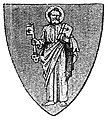
Coat of arms 1909
· 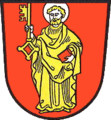
Crest 1970
· .jpg)
Trier city flag with the coat of arms of Peter
|
| Blazon: "In red, the standing, nimbed and gold-clad St. Peter with an upright, averted golden key in his right hand and a red book in his left." The city colors are gold-red. |
| Coat of arms justification: St. Peter as the city's patron saint can be traced in the city's seals as early as the 12th century. The depiction of the person changed several times and is since the 15th century in an upright position. The city colors were established only in the 19th century. |
Partnerships
Trier is a major center of the Saar-Lor-Lux-Rhineland-Palatinate-Wallonia metropolitan region along with Luxembourg, Metz and Saarbrücken, with which it has joined together to form the QuattroPole association of cities.
Trier has nine twin towns:
- United Kingdom
 Gloucester (United Kingdom) since May 1957
Gloucester (United Kingdom) since May 1957 - France
 Metz (France) since October 13, 1957
Metz (France) since October 13, 1957 - Italy
 Ascoli Piceno (Italy) since August 31, 1958
Ascoli Piceno (Italy) since August 31, 1958 - Netherlands
 Herzogenbusch (Netherlands) since June 7, 1968
Herzogenbusch (Netherlands) since June 7, 1968 - Croatia
 Pula (Croatia) since September 8, 1971
Pula (Croatia) since September 8, 1971 - United States
 Fort Worth (United States) since July 13, 1987
Fort Worth (United States) since July 13, 1987 - Germany
 Weimar (Germany) since May 24, 1987
Weimar (Germany) since May 24, 1987 - Japan
 Nagaoka (Japan) since June 2, 2006
Nagaoka (Japan) since June 2, 2006 - China People's Republic of
 Xiamen (People's Republic of China) since November 11, 2010
Xiamen (People's Republic of China) since November 11, 2010
Youth Parliament
Since the end of 2011, Trier has had a youth parliament that is elected for two years at a time.
.jpg)
Wolfram Leibe
Religion
History
Roman Catholic Christianity has played and continues to play an above-average role in Trier's history.
At the time of the Treverians, Celtic deities were worshipped in the temple districts in Trier-West below the Markusberg at a rock spring (temple district Irminenwingert) and in the Altbachtal. In the 2nd century a Gallo-Roman temple district was established in the Altbachtal with 70 temples and other cult sites on an area of about five hectares.
Constantine theGreat, emperor of the Roman Empire, who at times resided in Trier, openly revealed himself as a Christian from about the year 323. As was customary at the time, Constantine had not been baptized until shortly before his death in 337. Already since Constantine, Trier has been Christian.
Trier probably became the seat of a Christian bishop at the end of the 3rd century, who later rose to the position of archbishop. The latter ruled over a spiritual territory that was one of the electorates of the Holy Roman Empire of the German Nation from 1189 to 1806. One of the first German synagogues was built in 1066, and in 1096 there was a pogrom by the Crusaders against the Jews of Trier, whom the bishop was unable to defend. The Reformation was unable to gain a foothold in the episcopal city; however, Caspar Olevian, one of the most important German Reformed theologians, emerged from Trier. Trier remained a predominantly Catholic city; a minority of Trier's inhabitants professed Judaism. In the 17th century, the episcopal see was partially transferred to Koblenz. After the French occupied the archbishopric in 1794, the ecclesiastical province was finally dissolved in 1803 and the territory was incorporated into the later Prussian Rhine Province in 1815. However, Trier again became the seat of a bishop in 1821, whose diocese was newly circumscribed and assigned to the ecclesiastical province of Cologne (suffragan bishopric of Trier). The present parishes of the city have formed the Trier deanery within the Trier diocese since November 2003.
Trier is an important place of pilgrimage. In the cathedral is kept the Holy Rock (see Archbishop John I), which is exhibited at irregular intervals of a few decades. In addition, there are the Holy Rock Days. Another pilgrimage goes to the tomb of the Apostle Matthias. According to tradition, the only apostle's tomb north of the Alps is located in the Benedictine Abbey of St. Matthias (dial. also St. Mattheis). The bones of the Apostle Matthias are said to have been transferred to Trier by order of the Empress Helena, mother of the Roman Emperor Constantine I, by the Bishop Agritius of Trier. The main pilgrimage season is the week around Ascension Day.
After Trier became Prussian, Protestants also came to the city and founded a Protestant parish. After a year as a simultaneous church, the former Jesuit church became a Protestant parish church from 1819 until 1856. After that, the Constantine Basilica, which was rebuilt for this purpose, became a Protestant parish church and the Jesuit church was given back to the Catholics. The incorporation of the formerly independent town of Ehrang and other communities west of the Moselle in 1969 brought the present-day Protestant parish of Trier-Ehrang, which had been independent since 1946, with its church built in 1928-1930, to Trier. Today, the parish area of the Protestant parish of Trier-Ehrang includes the Trier districts west of the Moselle as well as roughly the area of the municipalities of Schweich, Trier-Land and Ruwer. The Christuskirche in the Heiligkreuz district, consecrated in 1963, was abandoned again in 2014. Today, all of Trier's Protestant Christians belong to the Evangelical Church District of Trier of the Evangelical Church in the Rhineland, unless they are members of a free church.
In addition to Protestant and Roman Catholic congregations, there are other free churches and religious communities in Trier: Evangelical Free Church congregation (Baptists), Free Evangelical congregation, Adventist congregation, Free Pentecostal congregation, Christian congregation, The Christian Community, Community of Christ, a New Apostolic church, Russian Orthodox congregation, and several congregations of Jehovah's Witnesses.
The Trier Jewish community, which had existed since the Middle Ages, possibly even since antiquity, was descended, among others, from Karl Marx, Trier's most famous son; many of his ancestors had been rabbis in Trier. The bishop of Trier, Matthias Eberhard, also came from a Jewish family on his father's side; his grandfather had converted to Catholicism.
A Buddhist center exists in Hornstraße. An Islamic cultural center with a mosque exists in Luxemburger Straße. The Turkish-Islamic Haci Bayram Camii in Konz is also responsible for Trier.
Under the name "les amis de l'humanité" a Masonic lodge was founded in 1805 under Napoleonic rule. This lodge still operates today in its lodge house in Brückenstraße under the name "Zum Verein der Menschenfreunde".
Trier is located on the Way of St. James, which leads pilgrims to Santiago de Compostela.
Denomination statistics
In 2007, Trier was home to nearly 67,500 Catholics, about 13,600 Protestants, about 2,000 Muslims and about 500 Jews. At the end of 2019, 55.6% of residents were Roman Catholic, 11.2% were Protestant, and 33.2% had no or another religious affiliation. At the end of 2018, 56.9% of residents were Roman Catholic, 11.6% were Protestant, and 31.6% had no or another religious affiliation.

Sarcophagus of the Apostle Matthias

Evangelical Church Trier-Ehrang

Synagogue in Kaiser Street
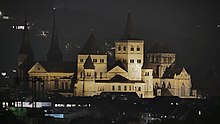
Cathedral (center) and Liebfrauen (far right)
Landmarks
The Roman buildings, which have survived to the present day, were designated as UNESCO World Heritage Roman Monuments, Cathedral and Church of Our Lady in Trier in 1986.
· The objects of the UNESCO World Heritage
·
Porta Nigra
· 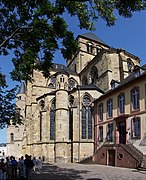
Liebfrauenkirche
·
High dome
· 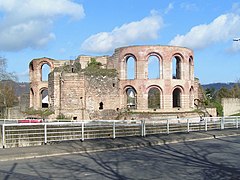
Imperial Baths
· 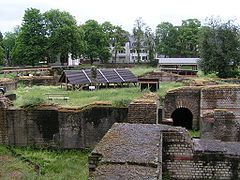
Barbara Baths
·
Constantine Basilica
·
Amphitheater
· 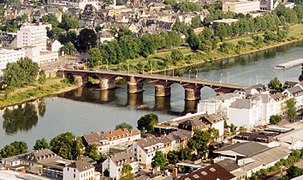
Roman bridge, view from the Marian column
· 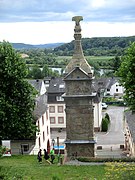
Hedgehog column, hedgehog
Ancient
- Porta Nigra, landmark of the city
- Amphitheater
- Baths (Roman baths): Imperial Baths, Barbara Baths and Viehmarkt Baths
- Roman Palastaula/Constantine Basilica (today Evangelical Church to the Savior)
- Roman bridge
- ancient burial ground (more than 1000 sarcophagi) under the imperial abbey church of St. Maximin
- Albanagruft and other Roman burial chambers on the grounds of the cemetery of the Benedictine Abbey of St. Matthias
- In the Pfalzel district, the so-called Küsterhaus, the oldest inhabited Roman stone house in Germany.
Middle Ages
- Trier Cathedral St. Peter (oldest cathedral in Germany)
- The Church of Our Lady (built in the earliest Gothic style in 1227-1243 and connected with the cathedral by a cloister)
- The medieval main market with Steipe, Red House, St. Gangolf, Market Cross, Petrusbrunnen and the nearby Judengasse (Jewish Alley)
- Benedictine Abbey of St. Matthias (Romanesque church with tomb of the Apostles)
- Fortified residential towers: Frankenturm, Turm Jerusalem, Konviktsturm
- Dreikönigenhaus (early gothic residential house)
- Moselle cranes (the older Moselle crane from 1413, also called "Alter Krahnen", and the baroque "(Old) Customs Crane" from 1774, also called "Younger Moselle Crane")
- Holy Cross Chapel in Trier-Heiligkreuz (Romanesque chapel)
- Zewener Tower (Zewen district)
- former collegiate church in Trier-Pfalzel (today in remains transept of the parish church)
- former canonical monastery Trier-Pfalzel (remains of the building substance today hotel and restaurant)
- Curia von der Leyen, at the Domfreihof 5
- Remains of the medieval Trier city wall, the city wall of today's Ehrang district and the fortifications in the Pfalzel district
17th and 18th century
- Electoral Palace
- Baroque palace Kesselstatt
- Löwen-Apotheke at the main market (oldest pharmacy in Germany)
- Walderdorff Palace
- Quinter Castle (Trier-Quint district)
- Saint George Fountain
- Baroque Basilica of St. Paulin
- former monastery church of St. Irminen
- Monaise Castle with park (Trier-Zewen district)
- St. Jost, chapel, infirmary and former leprosy cemetery (Trier-Biewer district)
- Old center of the Pallien district with the courtyard house of St. Martin's Abbey, craftsmen's and day laborers' houses and the church of St. Simon and Juda
·
Electoral Palace
· 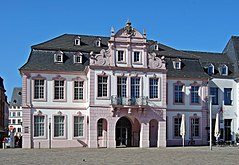
Walderdorff Palace
·
St. George Fountain
· 
St. Paulin
· 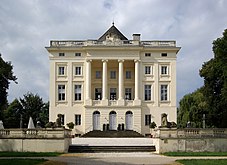
Monaise castle
· 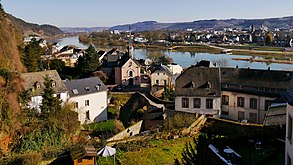
Old Pallien
1800 till 1933
- French casino
- Old Jewish cemetery at the Weidegasse
- Main cemetery Trier with graves from the 19th and 20th century, war graves of both world wars, Jewish cemetery part
- Art Nouveau houses in the areas of Eberhardstrasse, Fleischstrasse, Nagelstrasse, Neustrasse, Speestrasse and Im Gartenfeld
- Karl Marx House and Karl Marx Residence
- Maria Hilf Chapel with the tomb of Peter Friedhofen, the founder of the Order of the Brothers of Charity of Maria Hilf
- Marian column
- Balduin Fountain
- Catholic church buildings of historicism: Neo-Romanesque: St. Martin, Redemptorist Monastery of St. Joseph, Neo-Gothic: Sacred Heart of Jesus, St. Helena (Euren), St. Peter (Ehrang), St. Germanus in Trier-Feyen-Weismark, and of modernism: Convent Church of St. Clara of the Poor Clares Monastery on the Petrisberg (1930).
- Evangelical Church Trier-Ehrang
- Buildings of the partially preserved barracks complexes: Maximinkaserne (1802-ca. 1944), Palastkaserne (1803-1930), Städtische Kaserne (Trier) (also Gneisenaukaserne) (1899-ca. 1930), Hornkaserne (Trier) (1889-1930), Artilleriekaserne (Trier) (1912-1928), Goeben-Kaserne (Trier) (1912-1930), Jägerkaserne (Trier-Nord) (1913-1992), Jägerkaserne (Trier-West) (1913-2014), Kemmelkaserne on Petrisberg (1936-1999), Neue Hornkaserne (1937-1985), Kaserne Feyen (1938-1999), General-von-Seidel-Kaserne (1952-2012).
· 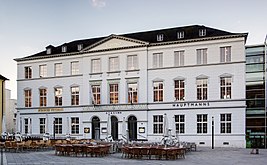
French casino
· 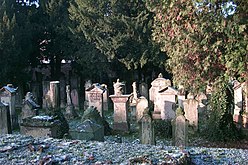
Old Jewish Cemetery
· 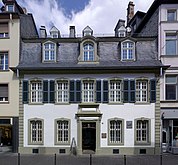
Karl Marx House
· 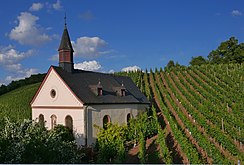
St. German ad undas
· 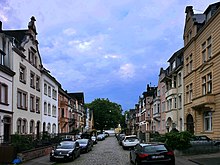
Speestraße monument zone
· 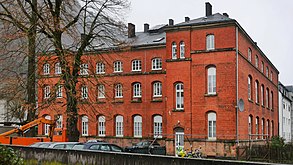
Horn Barracks
· 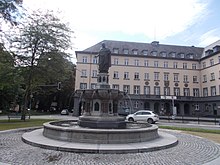
Balduin Fountain
National Socialism period
- Trier high bunker near the city hall
- Former National Socialist teacher training college (today old buildings on the Schneidershof campus of Trier University of Applied Sciences)
- Former state youth school for the Trier Hitler Youth in Trier-Biewer
- High bunker in Trier-West
- High bunker in Trier-North
- High bunker in Trier-Feyen
- Several Westwall bunkers on the border between Trier-Zewen and Igel as well as near Trier-Ruwer (at the Grüneberg and in the direction of Kenn)
·
High bunker city center
· 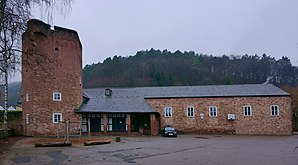
Former State Youth School
· 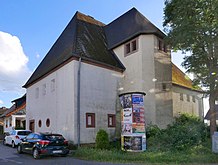
High bunker Trier-Feyen
· 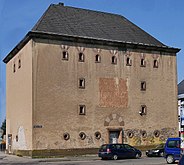
High bunker Trier-North
· 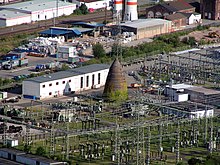
Angle tower bunker Trier-Pallien
Postwar
- Trier Main Cemetery: memorials to the horrors of Nazism and the World Wars: Memorial to the victims of the 1933-1945 tyranny, Memorial to 92 murdered Polish children, Memorial to the Soviet prisoners of war, etc.
- Settlement for French officers with buildings in timber frame construction. Built 1948-1950 in Trier North (Hochwaldstraße and Wittlicher Straße near Nells Park).
- Former military training area of the French Armed Forces with artificial ruins for house combat training and graffiti with African landscapes (above the district of Trier-Feyen)
- New building of the theater Trier by Gerhard Graubner from 1964
- Churches in Brutalist and Postmodernist styles: St. Michael in the Mariahof district - a pyramid-shaped church built in 1969/70 by the architect K. Schmitz; churches by the cathedral architect Karl Peter Böhr: St. Simeon (1966) in Trier-West, St. Agritius in Gartenfeld (1971), Maria-Hilf-Kapelle (Trier) (1990)
- Buildings in the elevated parts of the city: Water tower on the Petrisberg, telecommunications tower Trier-Petrisberg, buildings of the University of Trier, water band, tower Luxembourg.
- Buildings by Oswald Mathias Ungers: Protective building of the Viehmarktthermen, entrance area of the Kaiserthermen, forecourt of the Konstantinbasilika.
- The Karl Marx statue on Simeonstiftplatz was unveiled on May 5, 2018 to mark the 200th anniversary of Karl Marx's birth.
· 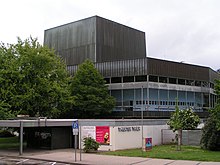
Theater Trier
· 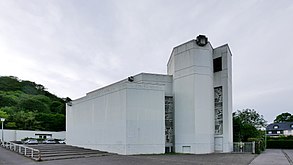
St. Simeon in Trier-West
· 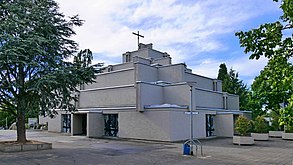
St. Michael in Mariahof
· 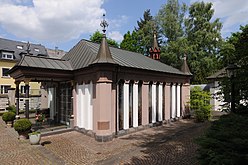
Mary Help Chapel
· 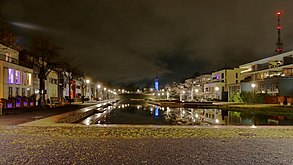
Water belt, water tower and transmission tower
· 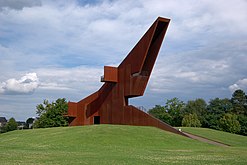
Tower Luxembourg
Parks and protected areas
Parks in Trier are Nells Park and the Palace Garden. The site of the former state horticultural show on the Petrisberg has been increasingly urbanized since 2004.
The nature reserves Gillenbachtal (47 hectares), the orchid biotope Kahlenberg at Sievenicherhof (15.5 hectares), Kenner Flur (31.4 hectares), gravel pit near Oberkirch (4.7 hectares) and Mattheiser Wald (447 hectares), which is also designated as a fauna-flora-habitat area, are located in Trier. See also: List of nature reserves in Trier.
Trier is located in the area of the protected landscape areas Meulenwald and Stadtwald Trier and Moselle Valley.
The areas of hedgerows near Trier-Eitelsbach, the former Löwenbrauerei beer garden and, on the right bank of the Moselle between Nordbad and Zollkran, the tree population along the Moselle cycle path in Trier are protected as landscape features. In addition, there are numerous natural monuments in Trier.
· 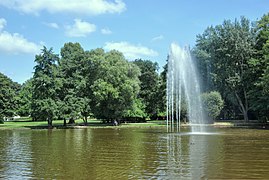
Nells Park
· 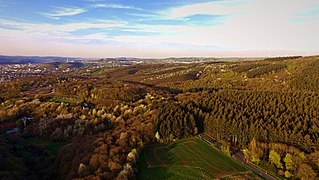
Nature reserve Mattheiser Forest
· 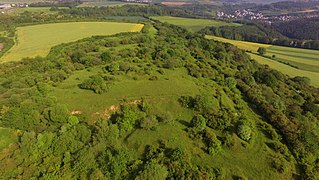
Orchid area at Kahlenberg
· 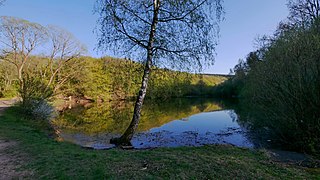
Pile pond in the Mattheiser forest
· 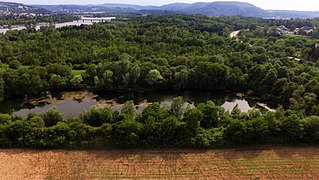
Gravel pit near Zewen-Oberkirch

Porta Nigra
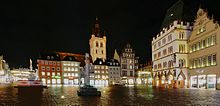
Main market

Holy Cross Chapel
Culture
As a city in the Greater Region, Trier took part in the program of the European Capital of Culture Year 2007 with the Constantine exhibition.
The exhibition Nero - Emperor, Artist and Tyrant was held in 2016.
On the occasion of the 200th anniversary of Karl Marx's birth in 2018, the Great National Exhibition KARL MARX 1818-1883. LIFE. WORK. ZEIT. both in the Rheinisches Landesmuseum Trier and in the Stadtmuseum Simeonstift Trier together with further exhibitions in the Museum Karl-Marx-Haus and in the Museum am Dom.
Theater
- Theater Trier (opera, operetta, musical, ballet, drama) with studio stage
- Trier Festival of Antiquities (1998 to 2010)
- Kleines Volkstheater Trier (amateur drama in Trier dialect since 1990)
Museums
- Rhineland Regional Museum (including a replica of the Igel column, antique finds, mosaic floors, Neumagen wine ship)
- Episcopal Cathedral and Diocesan Museum
- Simeonstift City Museum (including city model)
- Karl Marx House
- Toy Museum (tin toys, etc.)
- Treasury of the Trier City Library (manuscripts, Gutenberg Bible, Coronelli globes, maps, stained glass)
- Folklore and open-air museum Roscheider Hof (located in Konz directly on the boundary to Trier and founded in 1973 by the Trier-Saarburg district and the cities of Trier and Konz, among others)
- House of the Forest (Forest Museum) at the Dragon House in the White House Forest, game preserve, forest nature trail (Trier-Pallien)
- Transport Museum Trier
Visual arts
Art Clubs
- Trier Art Association Young Art
- G. B. KUNST, Society for Fine Arts Trier
Galleries
- Young Art Gallery
- Gallery Kaschenbach
Music
Choirs
- Trier Boys Choir
- Trier Bach Choir
- DOMMusic Trier
- Trier Cathedral Boys Choir
- Girls' choir at Trier Cathedral
- Trier Cathedral Choir
- Vocal Ensemble Cathedral of Trier
- Trier Concert Choir
- Extra choir at the Trier Theater
- Collegium Musicum of the University of Trier
- Frederick Spee Choir
- Gospel Voices Trier e. V.
- Mixed choir St. Medard e. V.
- Women's choir Polyhymnia
- Cantores Trevirenses
- Male Choral Society Trier-Euren 1912 e. V.
- Trierische Liedertafel 1835 e. V.
- Police Choir Trier 1981 e. V.
- Chorus of the Supervisory and Service Directorate
- Mixed choir Cäcilia 1888 Trier-Zewen
- Choir of SWT Stadtwerke Trier 1913.
- Treveris Choir Trier-Olewig 1913 e. V.
Orchestra
- Philharmonic Orchestra of the City of Trier
- Collegium Musicum of the Education and Media Center at Palais Walderdorff
- Collegium Musicum of the University of Trier
- "da capo" Orchestra Ehrang 1999 e. V.
- Reservistenmusikzug Trier 1966, the oldest reservist band in Germany
Music festivals
- International Organ Days in Trier Cathedral
- Summer cycle of organ concerts in the Constantine Basilica
- Summerblast Festival at the Youth and Cultural Center Exzellenzhaus
- Moselle Music Festival with national and international stars and orchestras
Carnival
The Trier Carnival is one of the largest carnival festivals in Rhineland-Palatinate, making Trier one of the major Rhenish carnival, shrovetide and carnival strongholds.
Youth Centers
Youth centers exist in Trier-Nord (Exzellenzhaus), Trier-Zentrum (Mergener Hof/MJC), Trier-Mariahof, Trier-Euren, Trier-Süd, Trier-Kürenz and Trier-Ehrang.
Cinemas
There are two cinemas in the city center, the program cinema Broadway Filmtheater and the multiplex CinemaxX. The cinema landscape is complemented by the programs of the film club F.ab! of Cineasta, Unifilm and the film club Le Septième Art e. V.
Events
Concerts of various styles are held in the Exhaus (short for Exzellenzhaus) and the Tufa (short for Tuchfabrik). Larger concerts are held either in the Messeparkhalle, Europahalle or, since June 2003, in the newly built Arena Trier.
The Kunsthalle der Europäischen Kunstakademie regularly organizes thematic exhibitions and vernissages with artists from Germany and abroad, as well as panel discussions, studio visits, summer festivals and concerts.
- Trier Carnival
- May to September: Trier Summer Meeting
- May to September: various local history and wine festivals: Zewener Strawberry Fair, Kürenzer Fair
- May: Europe Folk Festival in the Exhibition Park
- June: Old Town Festival (last weekend in June), Peter and Paul Fair
- July: Christopher Street Day
- July: Zurlaubener Heimatfest. In the picturesque former fishermen's quarter "Zurlauben" (vernacular: "Alt Zalawen"), located directly on the Moselle, one of the most beautiful quarter festivals takes place.
- August: Olewiger wine festival
- August: Heiligkreuz Fountain Festival
- August: wayside shrine festival Trier-Feyen
- August: Trier Flower Days
- August: Ehrang market
- September: Pfalzeler Kirmes
- October: Trier Wine Market of Mosel-Saar-Ruwer
- End of October/beginning of November: All Saints Mass
- November/December: Christmas market in the city center
- December/January: Trier Christmas Circus at the Exhibition Grounds
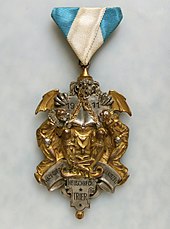
Carnival Order
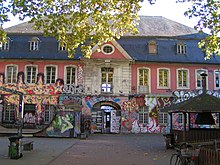
The Excellence House in Trier North

Tent of the Trier Christmas Circus (2017/18)
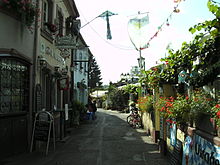
Former fishermen's quarter "Old Zalawen
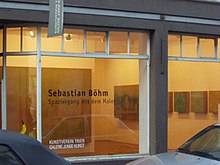
Trier Art Association Young Art
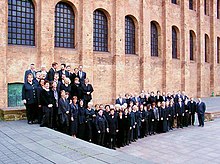
Trier Bach Choir at the Constantine Basilica

Rhenish Regional Museum Trier
Sports
According to the 2012 sports club survey, there are 112 sports clubs in Trier. A total of 21,297 athletes are organized in the 67 clubs that took part in the survey, with women underrepresented at 39.7 percent. The club with the largest number of members is the Post-Sportverein Trier with 3,300 members. Around 83 percent of all functionaries in the clubs surveyed work on a voluntary basis. The most popular sports are soccer for men and gymnastics for women.
Ball Sports
The Eintracht Trier soccer team made it to the semifinals of the 1998 DFB Cup, narrowly missing out on participation in the European Cup after a penalty shootout. In the summer of 2002, they managed promotion to the Second Bundesliga after a long absence, but were relegated back to the Regionalliga in 2005 and to the Oberliga a year later. Currently (2019/2020), Eintracht plays in the soccer Oberliga Rheinland-Pfalz/Saar.
Trier has been represented in the Basketball Bundesliga since 1990 by TVG Trier, now TBB Trier. In the 2007/08 season, the club was destined for relegation, but was able to retain the league through a wildcard procedure. Among its greatest successes, the club won the German Cup twice in 1998 and 2001. The women's handball team of DJK/MJC Trier ("Die Miezen") has played in the 1st Bundesliga since 2000 and won the German championship in 2003. Women's handball and basketball teams play their home games in the Arena Trier. The wheelchair basketball team RSC-Rollis Trier also plays in the 1st Bundesliga, playing its home games in the Mäusheckerhalle.
Furthermore, American sports also established themselves in Trier. The Trier Cardinals baseball team won the German championship in 1995 and 1996. However, after sponsors withdrew, a long decline began soon after. They currently play in the regional league of the Southwest German Baseball and Softball Association e. V. (SWBSV). The mixed softball team finished third in the unofficial German Softball Mixed Championship in 2007.
Another American sport, American football, is represented by two teams in the city. As early as 1990, the Trier Stampers of the Trier Post Sports Club were founded, and until their reestablishment in 1998, they still bore the name Trier Saints. They narrowly missed out on joining the 2nd Bundesliga in 1999. In the past two seasons (2013/2014), the men's team won the championships. Currently, the men's team plays in the regional league, the youth team in the youth upper league. Another football team is the Trier Wolverines, which was founded in January 2008 and reached the second place in the table of the youth development league with its youth team in the same year. In 2009, the newly formed men's team of the Wolverines established itself. The club regularly goes on the air with their American football magazine GRIDIRON on local TV station OK54, reporting on the Rhineland-Palatinate League and American football in general.
Furthermore, there is a rugby team that plays in the 3rd Bundesliga South-West. It plays for the FSV Trier-Tarforst.
Motorsport
In August, Trier and the surrounding area hosted the Rally Germany from 2000 to 2016, which has been part of the World Rally Championship since 2002. The International Trier Hill Climb was organized by Racing Team Trier 1967 e. V. from 1971 to 2011 and was a round of the European Hill Climb Championship since 1991.
Other sport
- The largest mass sports club in Trier is the Post-Sportverein with more than in offered sports in ebesovielen departments, which are partly also active in the field of competitive sports.
- The chess club SG Trier 1877 belonged to the Chess Bundesliga from 2007 to 2017.
- The Trier Go section of the German Go Federation plays as a joint team with Luxembourg (TriLux) in the 2nd Bundesliga. The Trier Go group is characterized above all by successful youth work, from which both the German youth champion in 2014 and the German school team champions in 2014 and 2015 (Friedrich-Wilhelm-Gymnasium) emerged.
- The Silvesterlauf Trier is held regularly on December 31. It is considered one of the best-attended year-end runs in Europe and is called "German São Paulo" in reference to the famous Brazilian New Year's Eve run.
- The club Trierer Kanufahrer 1948 (TKF) is located near today's modern Römerstadt youth hostel in the former youth hostel house (Hans-Karl-Schmitt-Haus). It celebrates national and international sporting successes in canoeing.
- The Skydiving Club Trier e. V. , located at the airfield Trier-Föhren, was founded in 1975.
- The PBC Trier plays in the 2nd Poolbillard Bundesliga.
- Swimming pools are The Baths at the Kaiserthermen, the Outdoor Pool North and the Outdoor Pool South.
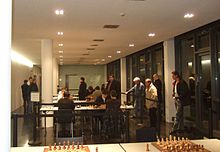
OSC Baden-Baden vs. SG Turm Trier
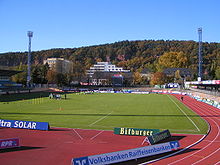
Mosel Stadium

Rally Germany in Trier
Economy and infrastructure
In 2016, Trier, within the city limits, produced a gross domestic product (GDP) of €4.741 billion, placing it 65th within the ranking of German cities by economic output. GDP per capita in the same year was €42,142 (Rhineland-Palatinate: €34,118, Germany €38,180). GDP per labor force was 58,640. In 2016, the city's GDP grew by 0.3% in nominal terms, compared to 4.7% in the previous year. There were approximately 80,900 employed persons in the city in 2016. The unemployment rate was 4.3% in December 2018, slightly above the Rhineland-Palatinate average of 4.1% (it was 2.5% in the neighboring Trier-Saarburg district).
In the 2016 Future Atlas, the independent city of Trier ranked 206th out of 402 counties, municipal associations and independent cities in Germany, making it one of the regions with a "balanced opportunity-risk mix" for the future.
Debt of the city of Trier
In 2011, the city's budget had revenues of 301 million euros against expenditures of 364 million euros. 63 million euros had to be financed through loans. In total, the city of Trier had 581 million euros in debt. In terms of per capita debt, Trier ranked fifth among the independent cities in Rhineland-Palatinate with 6,174 euros. This was the result of an analysis commissioned by the Trier Chamber of Commerce and Industry.
The debt in 2016 was 714,641,290 euros, or 6,545 euros per inhabitant. All independent cities in Rhineland-Palatinate had a per capita debt of 5,626 euros at that time.
Traffic
Inner-city individual traffic
For tens of thousands of people who commute daily between the Moselle valley and the high-altitude districts (Tarforst, Filsch, Irsch, Kernscheid), the university and the suburbanized towns behind the city limits, there are only three possible access routes by road: on the one hand, a road route leading along the south of the Petrisberg through the district of Olewig, on the other hand, the axis located in the north via the Kohlenstraße through the Avelertal in the district of Kürenz. In addition, it is possible to reach the Petrisberg with its emerging residential area, the university buildings and the technology park via Sickingenstraße, which passes the amphitheater and accesses the plateau via serpentines.
The above-mentioned areas are burdened by heavy through traffic, which has increased considerably in the last decade in particular, due to rapidly rising student numbers at the university, sharply rising population figures as a result of new residential areas in the elevated parts of the city, and the steadily increasing number of employees at the companies on the Petrisberg. A discussion about relief through local bypasses is underway, especially in Kürenz. In order to spare the residents here, a stronger burden of the residents by the heavy traffic in the area of the Olewiger Straße was accepted. So far, however, all considerations for relief roads or alternative transport concepts have failed due to financial aspects. From 2010 to 2012, it was discussed to realize the Petrisberg ascent by a separate public transport route, in the meantime one hopes express buses through the Moselbahn breakthrough, for which, however, there is still no completion date. The other problem is that Trier does not have a bypass for north-south traffic and therefore the corresponding traffic has to use the four-lane road on the eastern bank of the Moselle.
Supraregional road traffic
The following highways lead from/to Trier:
 Luxembourg (there Autoroute 1
Luxembourg (there Autoroute 1_number.png) )-Trier
)-Trier leads from Kenn over the Mosel bridge Ehrang to Trier-Ehrang
leads from Kenn over the Mosel bridge Ehrang to Trier-Ehrang leads from the Trier junction to the Moseltal interchange and from there to the A1 freeway
leads from the Trier junction to the Moseltal interchange and from there to the A1 freeway
The Moselaufstieg and the Meulenwaldautobahn are under discussion as the western and northern bypasses of Trier.
The following federal highways pass through the city area:
 Border crossing Wasserbillig (L)-Trier-Koblenz
Border crossing Wasserbillig (L)-Trier-Koblenz Border crossing Hanweiler (F)-Saarbrücken-Trier-Bitburg-Cologne
Border crossing Hanweiler (F)-Saarbrücken-Trier-Bitburg-Cologne Trier-Soft-Mehring-Bernkastel-Kues-Zell-Alf
Trier-Soft-Mehring-Bernkastel-Kues-Zell-Alf Trier-Losheim am See-Heusweiler-Riegelsberg-Saarbrücken
Trier-Losheim am See-Heusweiler-Riegelsberg-Saarbrücken
See also: List of state roads in Rhineland-Palatinate from L 1 and List of district roads in Trier
Public transport
→ Main article: Local transport in Trier
The local public transport is mainly operated by the bus lines of the Stadtwerke Trier (SWT). In addition, numerous unscheduled regional bus lines of various bus companies operate in Trier. The tariff of the Verkehrsverbund Region Trier (VRT) is valid on all bus lines in Trier.
The Trier tramway also existed from 1890 to 1951. It was replaced by the Trier trolleybus introduced in 1940, which in turn was discontinued in 1970.
Bridges
For almost two millennia, the only way to reach the left bank of the Moselle was via the Roman bridge, the first version of which was built in 18 BC / 17 BC. It was not until the beginning of the 20th century that the Kaiser Wilhelm Bridge followed as the second river crossing; in 1973, the Konrad Adenauer Bridge was added, which has since been the last road bridge completely within Germany (The next bridge leads 18 km upstream from Wellen to Grevenmacher). The Pfeiffersbrücke in Ehrang, the structure built in 1949 bridges the railroad line Koblenz-Trier and connects the Servaisstraße with the B 53. There is also a railroad bridge between Pfalzel and the industrial area north (Mosel route Trier-Koblenz), popularly called "Pfalzeler Brücke", which also allows pedestrians and cyclists to cross the Mosel. In the north of the city is the Moselle bridge Ehrang of the federal highway 64a between Trier-Ehrang and Kenn, which also allows pedestrians and cyclists to cross the Moselle. It connects the A 602 and the B 53, but due to its location it also has an inner-city development function. The Konzer Moselle Bridge leads from Konz to Trier-Zewen. It connects the Saar line and the Upper Moselle line with the Trier West line. In Trier-Pallien, the Napoleon Bridge spans the valley of the Sirzenicher Bach stream. It is part of the federal highway 51. The Aulbrücke in St. Matthias crosses the railroad line between the Trier Südbahnhof and Konz-Karthaus. Other bridges are the Biewerbachtalbrücke or the Gartenfeldbrücke.
·
Konrad Adenauer Bridge
· 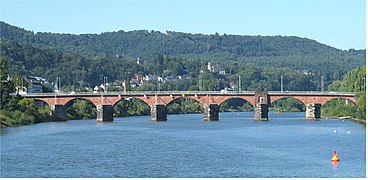
Roman bridge
· 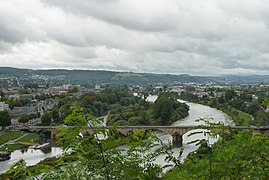
Kaiser Wilhelm Bridge
· 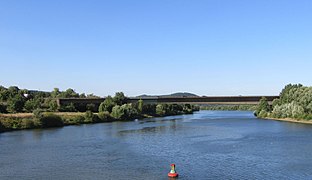
Moselle bridge Ehrang
Rail transport
The main station is located in the northeastern area of the city center between the Mitte-Gartenfeld and Nord districts. Trier is connected to Koblenz to the north via the Moselle line and to Cologne via the Eifel line; to the south, the Trier West line leads to Luxembourg, the Saar line to Saarbrücken and the Obermosel line to Perl or Metz (France). Through trains run from Koblenz to Saarbrücken and on to Mannheim or Luxembourg, and from Wittlich to Perl on Mondays to Fridays; otherwise, Trier's main station is usually the terminus. Other stops are Quint, Ehrang-Ort, Ehrang and Pfalzel in the northwest of the city center, and Trier Süd in the south. From December 11, 2005 to December 10, 2011, the city of Trier had an ICE direct connection to Berlin. Directly north of the main station is a depot of Deutsche Bahn (formerly Bahnbetriebswerk Trier). In Ehrang there is a former marshalling yard, which is, however, still used by Deutsche Bahn AG to a reduced extent as a freight station. In June 2008, the state of Rhineland-Palatinate decided that the Trier western line between Trier-Ehrang and Trier-Zewen should be reactivated for passenger traffic, especially to improve connections for commuters to Luxembourg. In addition, the construction of two new train stops at Trier Nord (probably at Dasbachstrasse) and Trier-Kaiserthermen (probably at Hermesstrasse) is planned on the Moselle line.
Air traffic
The nearest airport for national and international connections is Luxembourg Airport, about 40 kilometers away. Also, about 25 kilometers from the city center is the Trier airfield, which was relocated from Trier-Euren (in operation from 1910 to 1977) to Föhren. Frankfurt-Hahn airport is about 70 kilometers away and Saarbrücken airport is about 105 kilometers away.
Shipping
With the canalization of the Moselle between 1958 and 1964 into a major international shipping route, Trier is linked by inland waterway to the industrial region of Lorraine, the state of Luxembourg, the industrial centers of western Germany, and the North Sea ports in the Netherlands and Belgium. Trier is the seat of the Moselle Commission, founded in 1962 to regulate all matters relating to navigation on the Moselle. The Trier Port Company, founded in 1962, completed the commercial and industrial port in Trier-Ehrang in 1965. With its opening on May 26, 1965, Trier became a port city. The port of Trier is a transshipment point for goods traffic, which mainly consists of the transport of petroleum and mineral oil as well as ores and metal waste. An extension of the port facility has also allowed the handling of containers since 1998. The port facility is directly connected to the road and rail network.
Tourist attractions are the Moselle cruises on passenger ships both to Luxembourg and in the direction of Koblenz.
The Waterways and Shipping Office Trier existed since 1952 and came in 2019 by a merger with the offices in Koblenz and Saarbrücken to the Waterways and Shipping Office Mosel-Saar-Lahn with a location in Trier at the Pacelliufer.
Cycling and hiking trail network
The Moselle Cycle Path runs through the city and is part of the international Velo Tour Moselle cycling route. The Kylltal Cycle Path to the Eifel starts in Trier-Ehrang and the Ruwer-Hochwald Cycle Path to the Hunsrück starts in Trier-Ruwer. The Nahe-Hunsrück-Moselle Cycle Route runs between Bingen am Rhein and Trier.
In general, the network of bike paths in Trier's urban area is moderately developed. In particular, cyclists moving around the city often have to take narrow, busy roads and accept the corresponding safety risks. In 2010, the ADFC still rated the situation for cyclists in Trier as "poor to sufficient". However, in 2014, Trier received the "3rd catch-up" award in the city size group 100,000 to 200,000 inhabitants in the ADFC Bicycle Climate Test and is now ranked 29th out of 37 (lower 22%) (Cf. 2012: 39th out of 42: lower 8%).
Trier is a hub in the Rhineland-Palatinate hiking trail network. In addition to the Eifelsteig, the Saar-Hunsrück Climb also starts and ends here. A dream loop on the Saar-Hunsrück Climb is the Trier Galgenkopf Tour, a 15.8 km-long high-altitude trail that leads to the Naumeter Kopf, among other places. The Moselhöhenweg runs through the city of Trier on both the Eifel side and the Hunsrück side. Since April 2014, Trier has also been connected via the Moselsteig trail, which runs alternately on both sides of the Mosel valley. The Ausonius Trail from Trier to Bingen am Rhein has also been dedicated as the Hunsrück Way of St. James since June 2013.
Other traffic
Park-and-ride parking is available both in the southwest (Messepark) and in the north (Riverside/Distribution Circle) of the city. For larger events, the parking lot of Trier University at Schneidershof also serves as a park-and-ride lot. On Advent Saturdays, three special free P+R lines are offered every 10 minutes (financed by the City Initiative); otherwise, the parking lots are served by the normal regular service.
In the context of the withdrawal of French armed forces, the vacated areas are being used for conversion. It is planned to develop the former "Castel Feuvrier" between the Moselle and Zurmaiener Strasse with a hotel and apartments. Offered for sale by the Bundesanstalt für Immobilienaufgaben (Bima), the conversion site was acquired by the Immobiliengesellschaft Rheinland-Pfalz (IRP) on behalf of Porta Nova GmbH. Helmut Klein was managing director of both companies until January 31, 2012.
Company
With JT International and Heintz van Landewyck, Trier forms a center of the German cigarette industry. Other larger companies or public institutions are:
- Trier Savings Bank, 930 employees
- Trier municipal utility, 750 employees
- Steil Holding GmbH, 700 employees
- Steep crane work
- Köhl Maschinenbau GmbH, 600 employees
- Natus GmbH & Co. KG, switchgear systems 520 employees
- Defense Technology Center for Land Vehicle Systems, Engineer and Troop Technology, 420 employees
- Trier tax office, 400 employees
- Michelin (preliminary products for tires), 220 employees
- Volksbank Trier, 300 employees
- Special purpose association A.R.T. , 300 employees
- Landal GreenParks (Headquarters Germany)
- Karlsberg Brewery GmbH & Co KG
- Leyendecker HolzLand GmbH & Co. KG, founded in 1860, 130 employees
- Volksfreund-Druckerei Nikolaus Koch GmbH (Publisher)
- MAN Nutzfahrzeugvertrieb GmbH (Sales and Maintenance)
- Romika (shoe manufacturer)
- Schloss Wachenheim AG (sparkling wine producer)
- Peter Herres wine and sparkling wine cellar
- Bernard-Massard Sparkling Wine Cellars Ltd.
- Alwitra Flat Roof Systems GmbH & Co
- WestRock Packaging Systems Germany GmbH
- TRIWO AG, project developer and portfolio holder of commercial, industrial and special real estate, active nationwide
- Mercedes-Hess GmbH & Co KG
- Joh. Rendenbach jr. GmbH & Co. KG, one of the last tanneries working according to the traditional Eichenloh pit tanning method
Medicine
The city of Trier assumes the function of a senior medical center for the former administrative district of Trier as well as the Hochwald region and parts of the Saarland with maximum care services and specialized outpatient care. Only basic and standard care hospitals with 100 to about 300 beds are still located in the middle centers in the surrounding area, some of which are threatened with closure in the medium term. In the area of the city of Trier, there were originally six clinics; since the closure of Herz-Jesu-Krankenhaus in 2006, there are now five. In 2016, following the takeover of the clinic in Ehrang and the former Protestant Elisabeth Hospital by the parent hospital, there are now only three. In total, the city's clinics now have 1667 beds. In the Middle Ages, Trier also had, among others, the St. James Hospital and the St. Jost Leprosoria.
- Klinikum Mutterhaus der Borromäerinnen, 667 beds, 2500 employees
- Hospital of the Brothers of Mercy (Brüderkrankenhaus), 612 beds, 2400 employees
- Klinikum Mutterhaus der Borromäerinnen Trier-Nord (182 beds)
- Klinikum Mutterhaus der Borromäerinnen Trier-Ehrang (181 beds)
- St. Irminen Geriatric Rehabilitation Clinic, 80 beds, a social facility of the United Hospices
Media
Since the Trierische Landeszeitung was discontinued in 1974, the Trierischer Volksfreund (TV) has been the only regional daily newspaper. In addition, the "Rathauszeitung" is distributed free of charge to all municipal households as an official bulletin for official announcements. Also free of charge is the "Wochenspiegel", which is delivered to all households as a weekly newspaper. In the area of online media, there are several online portals/city magazines subject to a certain fluctuation, such as currently (2016) 5vier.de, lokalo.de or trier-reporter.de. One of them was the local news site "16vor" from 2007 to 2014, which was furthermore published as a printed magazine from 2014 to 2015. Furthermore, there is a studio of the public broadcaster Südwestrundfunk (SWR), which occasionally broadcasts the regionalized radio program SWR4 Rhineland-Palatinate from Trier, as well as a regional studio of the state-wide private radio station RPR1. The citizens' television station OK54 emerged from the Open Channel Trier, which was founded in 1987.
Since Saturday, November 13, 2010, Cityradio Trier has taken over the broadcast frequencies of 884 Trier. The private Rhineland-Palatinate radio station, uses the frequencies formerly occupied by Antenne West 88.4 MHz Trier-Petrisberg, 94.7 MHz Wittlich and 87.8 MHz Welschbillig. The station broadcasts an "Adult Contemporary"(AC) format that can be received in Trier and the surrounding area.
- Transmitters in Trier: Trier-Petrisberg telecommunications tower, SWR transmitter Trier-Markusberg, Trier transmitter
Education
Universities
- University of Trier, founded in 1473, closed in 1798 and reestablished in 1970 as part of the University of Trier-Kaiserslautern, made independent in 1975
- Trier University of Applied Sciences, founded in 1971 by uniting several predecessor institutions as the Trier Department of the University of Applied Sciences Rhineland-Palatinate. Became independent in 1996 as Trier University of Applied Sciences. Since September 12, 2012 Trier University of Applied Sciences, with campuses in Trier, Birkenfeld and Idar-Oberstein.
- Faculty of Theology Trier, organizationally independent university in close cooperation with the University of Trier (including use of the university's premises and services)
High Schools
- Friedrich-Wilhelm-Gymnasium (FWG), one of the oldest schools in Germany, founded in 1561 as a Jesuit college
- Humboldt-Gymnasium Trier (HGT), until March 31, 2009 Hindenburg-Gymnasium Trier
- Max Planck High School (MPG)
- Auguste-Viktoria-Gymnasium Trier (AVG)
- Friedrich-Spee-Gymnasium (FSG)
- Angela Merici High School (AMG), Episcopal girls' high school
- Free Waldorf School Trier (FWS)
- Vocational High School for Health and Social Affairs (GGS), Upper Secondary School at BBS Nutrition, Home Economics and Social Affairs (BBS EHS)
- Wirtschaftsgymnasium (WG), upper secondary school at BBS Wirtschaft (BBS W)
- Vocational high school for media and design technology (GMG), upper school at BBS Gewerbe und Technik (BBS GuT)
- Technical high school (TG), upper school at the Balthasar-Neumann-Technikum (BNT), sponsored by the district of Trier-Saarburg
Elementary Schools
- Elementary school at the Biewerbach
- Ambrosius Elementary School
- Ausonius Elementary School
- Barbara Elementary School
- Episcopal elementary school at the cathedral
- Egbert Elementary School
- Free Waldorf School
- Gregor-von-Pfalzel Elementary School
- Elementary school Feyen
- Elementary school Heiligkreuz
- Elementary school Trier-Irsch
- Johann Herrmann Primary School Euren
- Keune Primary School Kürenz
- Elementary school Mariahof
- Elementary school St. Martin
- Matthias Elementary School
- Elementary school Olewig
- Pallien elementary school
- Elementary school St. Peter Ehrang
- Elementary school Quint
- Elementary school Reichertsberg
- Elementary school Ruwer
- Elementary school Tarforst
- Elementary school Zewen
Realschulen and Realschulen plus
- Blandine-Merten-Realschule
- Kurfürst-Balduin-Realschule plus
- Nelson Mandela secondary school plus
- Moseltal Realschule plus Trier
- Private school St. Maximin
More schools
- Trier Integrated Comprehensive School, Montessoriweg
- Free Montessori School Trier e. V., An der Jugendherberge
- Balthasar-Neumann-Technikum (FS), technical college for technology, sponsored by the district of Trier-Saarburg
- St. Helena School Trier, Vocational School
Special schools and focus schools
- Private school St. Joseph
- Medard School
- Porta Nigra School
- Treverer School
- Wilhelm Hubert Cüppers School
Academies
- European Academy of Arts Trier - independent art academy, founded in 1977 by Erich Kraemer
- German Judicial Academy
- Academy of European Law - Training Center for Lawyers in European Law
- European Academy of Rhineland-Palatinate Sports
Other public facilities
Trier is the seat of one of two federal treasuries as well as a branch office of the Federal Real Estate Agency.
Judicial authorities are the Trier Local Court, the Trier Regional Court, the Trier Labor Court, the Trier Social Court, the Trier Administrative Court, the Trier Public Prosecutor's Office or the Trier Prison in Trier-Euren.
Trier is home to a federal police station, the Trier state police headquarters, the Trier Technical Relief Agency and the Bundeswehr Technical Center for Land Mobile Systems, Pioneer and Troop Technology in Trier-Kürenz; the Rhineland-Palatinate Court of Audit (Speyer headquarters) has a branch office.
Other institutions include the Trier Fire Department, the Trier Chamber of Crafts and the Trier Student Union.

Building of the German Judicial Academy
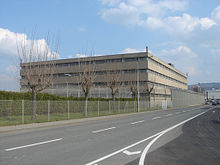
Trier Prison in the district of Euren
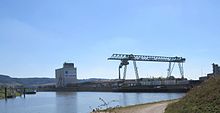
Trier port
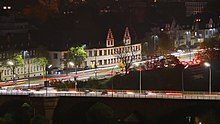
Traffic jam on the bank of Martin
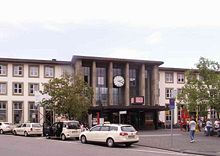
Trier main station (2006)
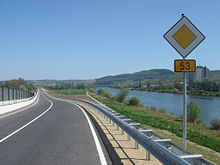
B 53 in Trier-Biewer (new bypass)
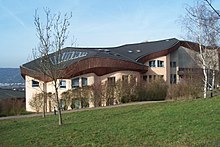
Free Waldorf School

Friedrich-Wilhelm-Gymnasium
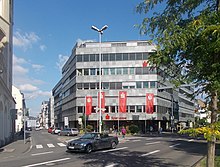
Trier Savings Bank

People's Bank Trier

Hospital of the Brothers of Mercy
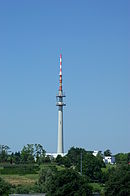
Telecommunication tower Trier-Petrisberg
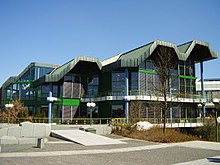
University of Trier, Library

Trier University of Applied Sciences, main campus
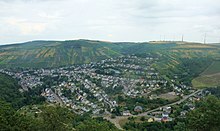
View from Naumeter head

Trier Chamber of Commerce and Industry

Trees along the Moselle cycle path
Personalities
→ Main article: List of personalities of the city of Trier
Panoramas

enlarge and show information about the image
![]()
View from the Way of the Cross over the city. On the hill (right of the cathedral) the Marian column.

enlarge and show information about the image
![]()
City panorama from St. Mary's Column (opposite perspective)
Trier as a name giver for other places
- New Trier is a town in Dakota County, Minnesota, United States.
- New Trier Township is a township in Cook County, Illinois, United States. New Trier High School is part of New Trier Township and features an image of the Porta Nigra in its logo.
- Neu-Trier was a mission station in the former German colony of German East Africa. Today: Mbulu (Iraqw Imboru, German formerly Neu-Trier) is the capital of the district of the same name in the Manyara region of Tanzania.
See also
![]()
Portal: Trier - Overview of Wikipedia content related to Trier
- Category: Street in Trier
- List of streets and squares in Trier
Search within the encyclopedia
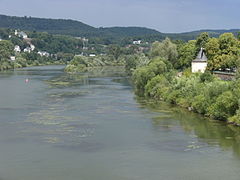
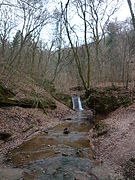
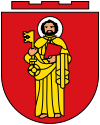
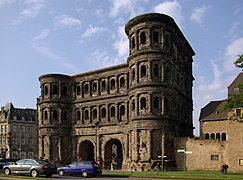
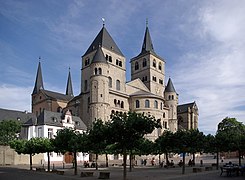
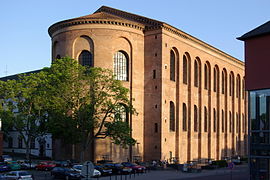
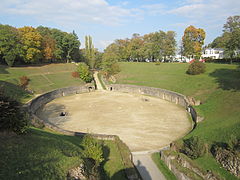
.JPG)
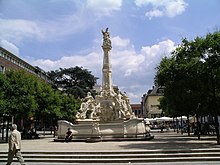
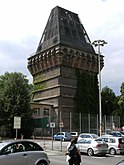
_2011.JPG)